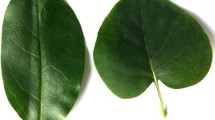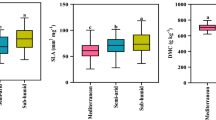Abstract
Dwarf bamboos are an important understory component of the lowland and montane forests in the subtropical regions of Asia and South America, yet little is known about their physiology and phenotypic plasticity in response to changing light environments. To understand how bamboo species adapt to different light intensities, we examined leaf morphological, anatomical, and physiological differentiation of Sinarundinaria nitida (Mitford) Nakai, a subtropical woody dwarf bamboo, growing in open and shaded natural habitats in the Ailao Mountains, SW China. Compared with leaves in open areas, leaves in shaded areas had higher values in leaf size, specific leaf area, leaf nitrogen, and chlorophyll concentrations per unit area but lower values in leaf thickness, vein density, stomatal density, leaf carbon concentration, and total soluble sugar concentration. However, stomatal size and leaf phosphorus concentration per unit mass remained relatively constant regardless of light regime. Leaves in the open habitat exhibited a higher light-saturated net photosynthetic rate, dark respiration rate, non-photochemical quenching, and electron transport rate than those in the shaded habitat. The results of this study revealed that the bamboo species exhibited a high plasticity of its leaf structural and functional traits in response to different irradiances. The combination of high plasticity in leaf morphological, anatomical, and physiological traits allows this bamboo species to grow in heterogeneous habitats.







Similar content being viewed by others
Abbreviations
- A max :
-
Light-saturated net photosynthetic rate
- Chl:
-
Chlorophyll
- ETR:
-
Electron transport rate
- F v /F m :
-
Maximal quantum efficiency of PSII
- LCP:
-
Light compensation point
- LSP:
-
Light-saturation point
- NPQ:
-
Non-photochemical quenching
- PPFD:
-
Photosynthetic photon flux density
- PSII:
-
Photosynthetic II
- R d :
-
Dark respiration rate
- SLA:
-
Specific leaf area
- WUE:
-
Water use efficiency
- δ13C:
-
Carbon isotopic composition
References
Abe M, Izaki J, Miguchi H, Masaki T, Makita A, Nakashizuka T (2002) The effect of Sasa and canopy gap formation on tree regeneration in an old beech forest. J Veg Sci 13:565–574
Alpert P (1996) Nutrient sharing in natural clonal fragments of Fragaria chiloensis. J Ecol 84:395–406
Alpert P (1999) Effects of clonal integration on plant plasticity in Fragaria chiloensis. Plant Ecol 141:99–106
Anten NPR, Hirose T (1999) Interspecific differences in above-ground growth patterns results in spatial and temporal partitioning of light among species in a tall-grass meadow. J Ecol 87:583–597
Bilger W, Björkman O (1990) Role of the xanthophyll cycle in photoprotection elucidated by measurements of light induced absorbance changes, fluorescence and photosynthesis in leaves of Hedera canariensis. Photosynth Res 25:173–185
Bond BJ, Farnsworth BT, Coulombe RA, Winner WE (1999) Foliage physiology and biochemistry in response to light gradients in conifers with varying shade tolerance. Oecologia 120:183–192
Brodribb TJ, Jordan GJ (2011) Water supply and demand remain balanced during leaf acclimation of Nothofagus cunninghamii trees. New Phytol 192:437–448
Brodribb TJ, Feild TS, Jordan GJ (2007) Leaf maximum photosynthetic rate and venation are links by hydraulics. Plant Physiol 144:1890–1898
Cao KF (2000) Leaf anatomy and chlorophyll content of 12 woody species in contrasting light conditions in a Bornean heath forest. Can J Bot 78:1245–1253
Chen JW, Zhang Q, Li XS, Cao KF (2011) Steady and dynamic photosynthetic responses of seedlings from contrasting successional groups under low-light growth conditions. Physiol Plant 141:84–95
Dong M (1995) Morphological responses to local light conditions in clonal herbs from contrasting habitats, and their modification due to physiological integration. Oecologia 101:282–288
Evans JR (1989) Photosynthesis and nitrogen relationship in leaves of C3 plants. Oecologia 78:9–19
Farquhar GD O, Leary MH, Berry JA (1982) On the relationship between carbon isotope discrimination and the intercellular carbon dioxide concentration in leaves. Aust J Plant Physiol 9:121–137
Farquhar GD, Ehleringer JR, Hubick KT (1989) Carbon isotope discrimination and photosynthesis. Annu Rev Plant Physiol Plant Mol Biol 40:503–537
Franks PJ, Beerling DJ (2009) Maximum leaf conductance driven by CO2 effects on stomatal size and density over geologic time. Proc Natl Acad Sci USA 106:10343–10347
Friedman D, Alpert P (1991) Reciprocal transport between ramets increases growth of Fragaria chiloensis when light and nitrogen occur in separate patches but only if patches are rich. Oecologia 86:76–80
Givnish TJ (1988) Adaptation to sun and shade: a whole-plant perspective. Aust J Plant Physiol 15:63–92
González ME, Veblen TT, Donoso C, Valeria L (2002) Tree regeneration responses in a lowland Nothofagus dominated forest after bamboo died-back in South-Central Chile. Plant Ecol 161:59–73
Griscom BW, Ashton PMS (2003) Bamboo control of forest succession: Guadua sarcocarpa in Southeastern Peru. For Ecol Manage 175:445–454
Hanba YT, Kogami H, Terashima I (2002) The effect of growth irradiance on leaf anatomy and photosynthesis in Acer species differing in light demand. Plant Cell Environ 25:1021–1030
Holtum JAM, Winter K (2005) Carbon isotope composition of canopy leaves in a tropical forest in Panama throughout a seasonal cycle. Trees 19:545–551
Holz A, Veblen TT (2006) Tree regeneration responses to Chusquea Montana bamboo die-off in a subalpine Nothofagus forest in the southern Andes. J Veg Sci 17:19–28
Huang D, Wu L, Chen JR, Dong L (2011) Morphological plasticity, photosynthesis and chlorophyll fluorescence of Athyrium pachyphlebium at different shade levels. Photosynthetica 49:611–618
Hutchings MJ (1997) Resource allocation patterns in clonal herbs and their consequences for growth. In: Bazzaz FA, Grace J (eds) Plant resource allocation. Academic, New York, pp 161–189
Küppers M, Timm H, Orth F, Stegemann J, Stöber R, Schneider H, Paliwal K, Karunaichamy KSTK, Ortiz R (1996) Effects of light environment and successional status on lightflecks use by understory trees of temperature and tropical forests. Tree Physiol 16:69–80
Larpkern P, Moe SR, Totland O (2011) Bamboo dominance reduces tree regeneration in a disturbed tropical forest. Oecologia 165:161–168
Lei TT, Koike T (1998) Functional leaf phenotypes for shaded and open environments of a dominant dwarf bamboo (Sasa senanensis) in northern Japan. Int J Plant Sci 159:812–820
Lusk C, Reich PB, Montgomery RA, Ackerly DD, Cavender-Bares J (2008) Why are evergreen leaves so contrary about shade? Trends Ecol Evol 23:299–303
Maxwell K, Johnson GN (2000) Chlorophyll fluorescence—a practical guide. J Exp Bot 51:659–668
Montti L, Campanello PI, Gatti MG, Blunodo C, Austin AT, Sala OE, Goldstein G (2011) Understory bamboo flowering provides a very narrow light window of opportunity for canopy-tree recruitment in a neotropical forest of Misiones, Argentina. For Ecol Manag 262:1360–1369
Montti L, Villagra M, Campanello PI, Gatti MG, Goldstein G (2013) Functional traits enhance invasiveness of bamboos over co-occurring tree saplings in the semideciduous Atlantic Forest. Acta Oecol (in press). doi:10.1016/j.actao.2013.03.004
Mulkey SS (1986) Photosynthetic acclimation and water-use efficiency of three species of understory herbaceous bamboo (Gramineae) in Panama. Oecologia 70:514–519
Murphy MRC, Jordan GJ, Brodribb TJ (2012) Differential leaf expansion can enable hydraulic acclimation to sun and shade. Plant Cell Environ 35:1407–1418
Niinemets Ü (1999) Components of leaf dry mass per area—thickness and density—alter leaf photosynthetic capacity in reverse directions in woody plants. New Phytol 144:35–57
Niinemets Ü, Kull O, Tenhunen JD (1998) An analysis of light effects on foliar morphology, physiology, and light interception in temperate deciduous woody species of contrasting shade tolerance. Tree Physiol 18:681–696
Pearcy RW, Sims DA (1994) Photosynthetic acclimation to changing light environments: scaling from the leaf to the whole plant. In: Caldwell MM, Pearcy RW (eds) Exploitation of environmental heterogeneity by plants: ecophysiological processes above and below ground. Academic, San Diego, pp 145–174
Poorter L (1999) Growth responses of 15 rain-forest tree species to a light gradient: the relative importance of morphological and physiological traits. Funct Ecol 13:396–410
Poorter L, Oberbauer SF (1993) Photosynthetic induction responses of two rainforest tree species in relation to light environment. Oecologia 96:193–199
Poorter H, Niinemets Ü, Poorter L, Wright IJ, Villar R (2009) Causes and consequences of variation in leaf mass per area (LMA): a meta-analysis. New Phytol 182:565–588
Reich PB, Walters MB, Ellsworth DS (1991) Leaf age and season influence the relationships between leaf nitrogen, leaf mass per area, and photosynthesis in maple and oak trees. Plant Cell Environ 14:251–259
Rozendaal DMA, Hurtado VH, Poorter L (2006) Plasticity in leaf traits of 38 tropical tree species in response to light; relationships with light demand and adult stature. Funct Ecol 20:207–216
Sack L, Frole K (2006) Leaf structural diversity is related to hydraulic capacity in tropical rain forest trees. Ecology 87:483–491
Sack L, Scoffoni C (2013) Leaf venation: structure, function, development, evolution, ecology and applications in the past, present, and future. New Phytol 198:983–1000
Sack L, Cowan PD, Jaikumar N, Holbrook NM (2003) The “hydrology” of leaves: co-ordination of structure and function in temperate woody species. Plant Cell Environ 26:1343–1356
Saitoh T, Seiwa K, Nishiwaki A (2002) Importance of physiological integration of dwarf bamboo to persistence in forest understory: a field experiment. J Ecol 90:78–85
Singh AN, Singh JS (1999) Biomass net primary production and impact of bamboo plantation on soil redevelopment in a dry tropical region. For Ecol Manag 119:195–207
Soderstrom TR, Calderon CE (1979) Ecology and phytosociology of bamboo vegetation. In: Numata M (ed) Ecology of grasslands and bamboolands in the world. W. Junk, The Hague, pp 223–236
Thornley JHM (1976) Mathematical models in plant physiology. Academic, London, p 318
Tobita H, Utsugi H, Kitao M, Kayama M, Uemura A, Kitaoka S, Maruyama Y (2010) Variation in photoinhibition among Sasa senanensis, Quercus mongolica, and Acer mono in the understory of a deciduous broad-leaved forest exposed to canopy gaps caused by typhoons. Trees 24:307–319
Tripathi SK (2006) The effects of understorey dwarf bamboo (Sasa kurilensis) removal on soil fertility in a Betula ermanii forest of northern Japan. Ecol Res 21:315–320
Valladares F, Gianoli E, Gómez JM (2007) Ecological limits to plant phenotypic plasticity. New Phytol 176:749–763
Veblen TT (1982) Growth patterns of Chusquea bamboo in the understory of Chilean Nothofagus forests and their influences in forest dynamics. Bull Torrey Bot Club 109:474–487
Wright IJ, Westoby M, Reich PB (2002) Convergence towards higher leaf mass per area in dry and nutrient-poor habitats has different consequences for leaf lifespan. J Ecol 90:534–543
Wyka T, Robakowski P, Zytkowiak R (2008) Leaf age as a factor in anatomical and physiological acclimative responses of Taxus baccata L. needles to contrasting irradiance environments. Photosynth Res 95:87–99
Yang SJ, Zhang YJ, Sun M, Goldstein G, Cao KF (2012) Recovery of diurnal depression of leaf hydraulic conductance in a subtropical woody bamboo species: embolism refilling by nocturnal root pressure. Tree Physiol 32:414–422
Yoshimura K (2010) Irradiance heterogeneity within crown affects photosynthetic capacity and nitrogen distribution of leaves in Cedrela sinensis. Plant Cell Environ 33:750–758
Zhang SB, Yin LX (2012) Plasticity in photosynthesis and functional leaf traits of Meconopsis horridula var. racemosa in response to growth irradiance. Bot Stud 53:335–343
Zhang SB, Hu H, Xu K, Li ZR, Yang YP (2007) Flexible and reversible responses to different irradiance levels during photosynthetic acclimation of Cypripedium guttatum. J Plant Physiol 164:611–620
Zhang Q, Chen YJ, Song LY, Niu N, Sun LL, Peng CL (2012) Utilization of lightflecks by seedlings of five dominant tree species of different subtropical forest successional stages under low-light growth conditions. Tree Physiol 32:545–553
Acknowledgments
The authors are grateful to Megan K. Bartlett (University of California Los Angeles, USA) for her valuable suggestions for the manuscript. We also thank the Ailaoshan Station for Subtropical Forest Ecosystem Studies (ASSFE) for logistic support and facilities. This research was financially supported by National Natural Science Foundation of China (Grant No. 31170399) and the Science Foundation of the Chinese Academy of Sciences 135 Program (XTBG-T01).
Author information
Authors and Affiliations
Corresponding author
Rights and permissions
About this article
Cite this article
Yang, SJ., Sun, M., Zhang, YJ. et al. Strong leaf morphological, anatomical, and physiological responses of a subtropical woody bamboo (Sinarundinaria nitida) to contrasting light environments. Plant Ecol 215, 97–109 (2014). https://doi.org/10.1007/s11258-013-0281-z
Received:
Accepted:
Published:
Issue Date:
DOI: https://doi.org/10.1007/s11258-013-0281-z




